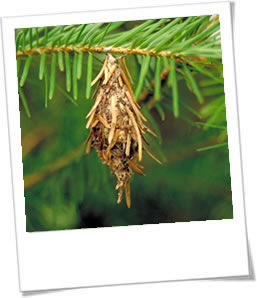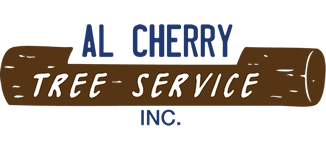| |
 The bagworm is a perennial insect pest of arborvitae, juniper, pine, spruce, and many other evergreen species. It also attacks certain deciduous trees such as black locust, honeylocust, and sycamore. The bagworm is most common in southern regions of Pennsylvania. Infestations have recently been noticed north of Interstate 80 in the state. The spread of the bagworm is slow since adult females are unable to fly. Their dispersal over wide areas occurs mainly through movement of infested nursery stock and ornamental plants, or by ballooning (wind dispersal) of small bagworm larvae during early June. The bagworm is a perennial insect pest of arborvitae, juniper, pine, spruce, and many other evergreen species. It also attacks certain deciduous trees such as black locust, honeylocust, and sycamore. The bagworm is most common in southern regions of Pennsylvania. Infestations have recently been noticed north of Interstate 80 in the state. The spread of the bagworm is slow since adult females are unable to fly. Their dispersal over wide areas occurs mainly through movement of infested nursery stock and ornamental plants, or by ballooning (wind dispersal) of small bagworm larvae during early June.
Bagworm Description
This insect is most easily recognized by the case or bag that the caterpillar forms and suspends from ornamental plants on which it feeds. The bag is made of silk and bits of host foliage. These materials are interwoven to disguise and add strength to the case. When the larva is mature, the bag may be 30 to 50 mm long. Young larvae hatching from the eggs are approximately two mm long, glossy black on the back and dull amber on the undersurface of their bodies. Mature larvae are dull, dirty gray and splotched with darker markings toward the head. Fully developed larvae are about 18 to 25 mm long. The adult female is worm-like. The adult female lacks eyes, wings, functional legs and mouthparts. She never leaves the bag that she constructed as a larva. The adult male is sooty black and moth-like with transparent wings that are nearly devoid of scales.
Bagworm Life History
This pest overwinters as eggs inside the female's abdomen inside the bag she constructed. Females lay 500-1000 eggs in each bag during the previous fall. Eggs start hatching from late May through early June. Upon hatching, young larvae crawl out of the bag and start to feed and construct silken shelters over their bodies. As the larvae (Image 1) grow over the eight to ten week feeding period, they continue to enlarge the exterior of their bags with pieces of foliage, bits of bark, or other plant parts. Feeding and development usually continue until August. Mature larvae loop strands of silk around a twig and become firmly attached. After the top of the bag is closed, larvae reverse their position in the bags so that their heads face downward. They then change into the pupal (resting) stage and remain in this life stage for about 4 weeks. During September and early October the males (Image 2) leave their cases and fly to bags containing females where mating takes place. Each mated female deposits a mass of eggs inside her bag. She crawls out of the bag after laying eggs, drops to the ground and dies. This pest species spends the winter inside the bag until the following spring. There is only one generation a year in Pennsylvania.
Bagworm Damage
Bagworm larvae injure plants when they feed on needles and leaves. Young caterpillars feed on the upper epidermis of host plants, sometimes leaving small holes in the foliage. Damage by mature larvae is especially destructive to evergreen plants. Trees such as sycamore, willow, and other deciduous trees, usually refoliate after an episode of heavy defoliation. Unfortunately, bagworm infestations generally go undetected until damage is complete, and the large bags constructed by this pest are very conspicuous. Early detection of an infestation requires careful examination of host plants for the presence of small bagworms attached to the leaves or needles.
Bagworm Management
Non-chemical
The bagworm may be managed on small shrubs and trees by handpicking or cutting the bags from infested plants during late fall, winter, or early spring, before egg hatch. Dispose of the bags so that this pest will not reenter your landscape. A number of natural enemies attack the larval and egg stages of the bagworm. Apparently, natural enemies are responsible for bagworm population changes from year to year. The species of parasites that attack this insect can be observed by collecting dozens of bags in the winter and placing them in a fine screen cage. Observe the cage frequently during April and May. These natural enemies should emerge from the bagworm and can be seen flying around inside the cage. A sex pheromone has been identified that when used in traps to lure the male moths, has successfully interfered with this pest’s mating behavior.
Chemical
When bagworms are too numerous to handpick, an insecticide application may be indicated. Several registered insecticide formulations are labeled for bagworm management. These products should be applied from early to mid-June while the larvae are small. Otherwise, treatments will not be as effective against larger larvae. However, to avoid damaging valuable plants, apply the material only to plants that are specified on the label. Be sure to follow all insecticide label directions.
Warning
Pesticides are poisonous. Read and follow directions and safety precautions on labels. Handle carefully and store in original labeled containers out of the reach of children, pets, and livestock. Dispose of empty containers right away, in a safe manner and place. Do not contaminate forage, streams, or ponds.
Authored by: Gregory A. Hoover, Sr. Extension Associate
Revised November 2010 (http://ento.psu.edu/extension/factsheets/bagworm)
Monitor of the Bagworm is essential. Call one of our certified Arborists today to review your tree health and recommend a solution for your Bagworm infestation.
| |
If you think your trees have been infected by the Bagworm,
call 215-672-6777
to schedule a Free Tree Health Evaluation. |
| |
|
|


 The bagworm is a perennial insect pest of arborvitae, juniper, pine, spruce, and many other evergreen species. It also attacks certain deciduous trees such as black locust, honeylocust, and sycamore. The bagworm is most common in southern regions of Pennsylvania. Infestations have recently been noticed north of Interstate 80 in the state. The spread of the bagworm is slow since adult females are unable to fly. Their dispersal over wide areas occurs mainly through movement of infested nursery stock and ornamental plants, or by ballooning (wind dispersal) of small bagworm larvae during early June.
The bagworm is a perennial insect pest of arborvitae, juniper, pine, spruce, and many other evergreen species. It also attacks certain deciduous trees such as black locust, honeylocust, and sycamore. The bagworm is most common in southern regions of Pennsylvania. Infestations have recently been noticed north of Interstate 80 in the state. The spread of the bagworm is slow since adult females are unable to fly. Their dispersal over wide areas occurs mainly through movement of infested nursery stock and ornamental plants, or by ballooning (wind dispersal) of small bagworm larvae during early June.